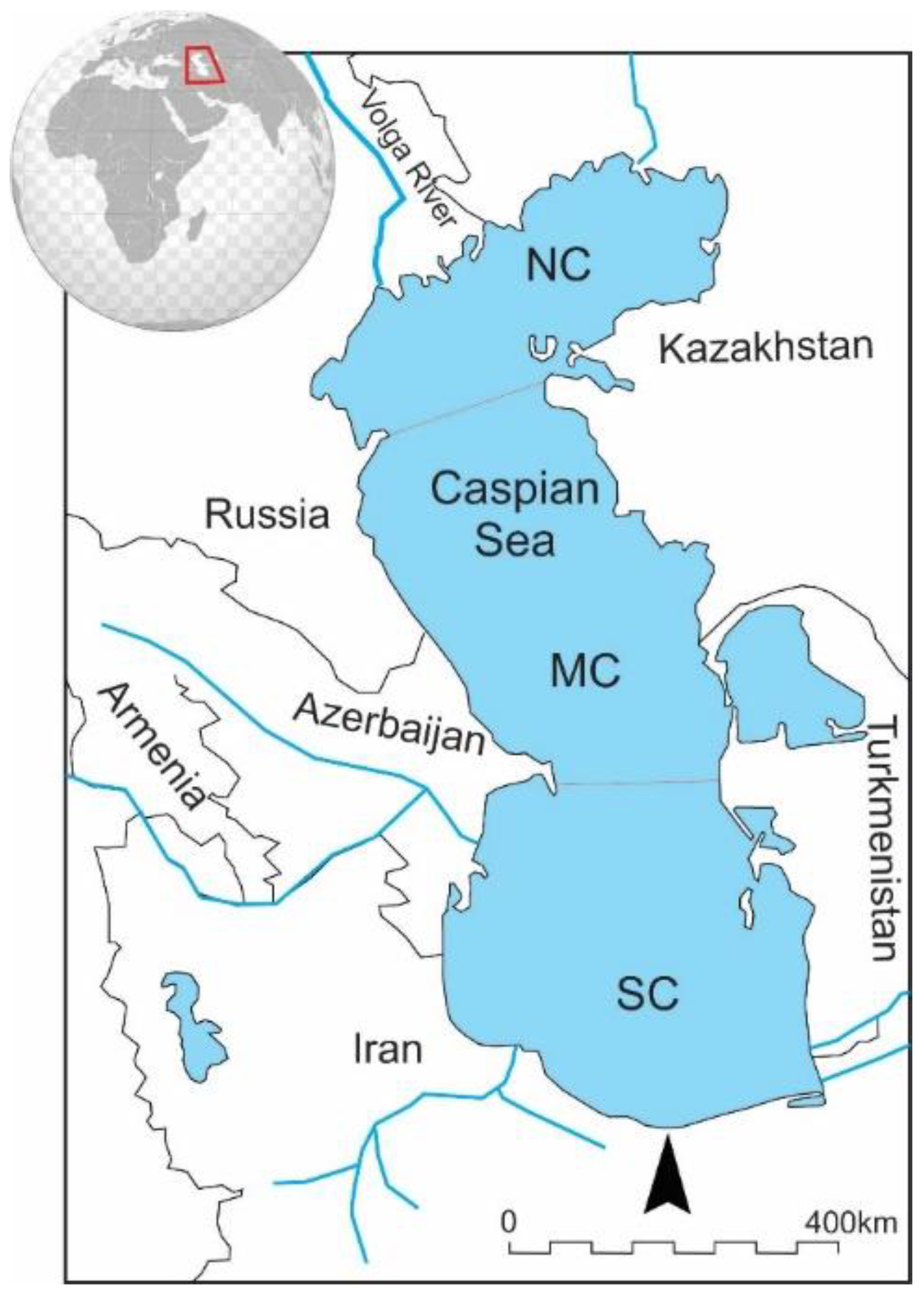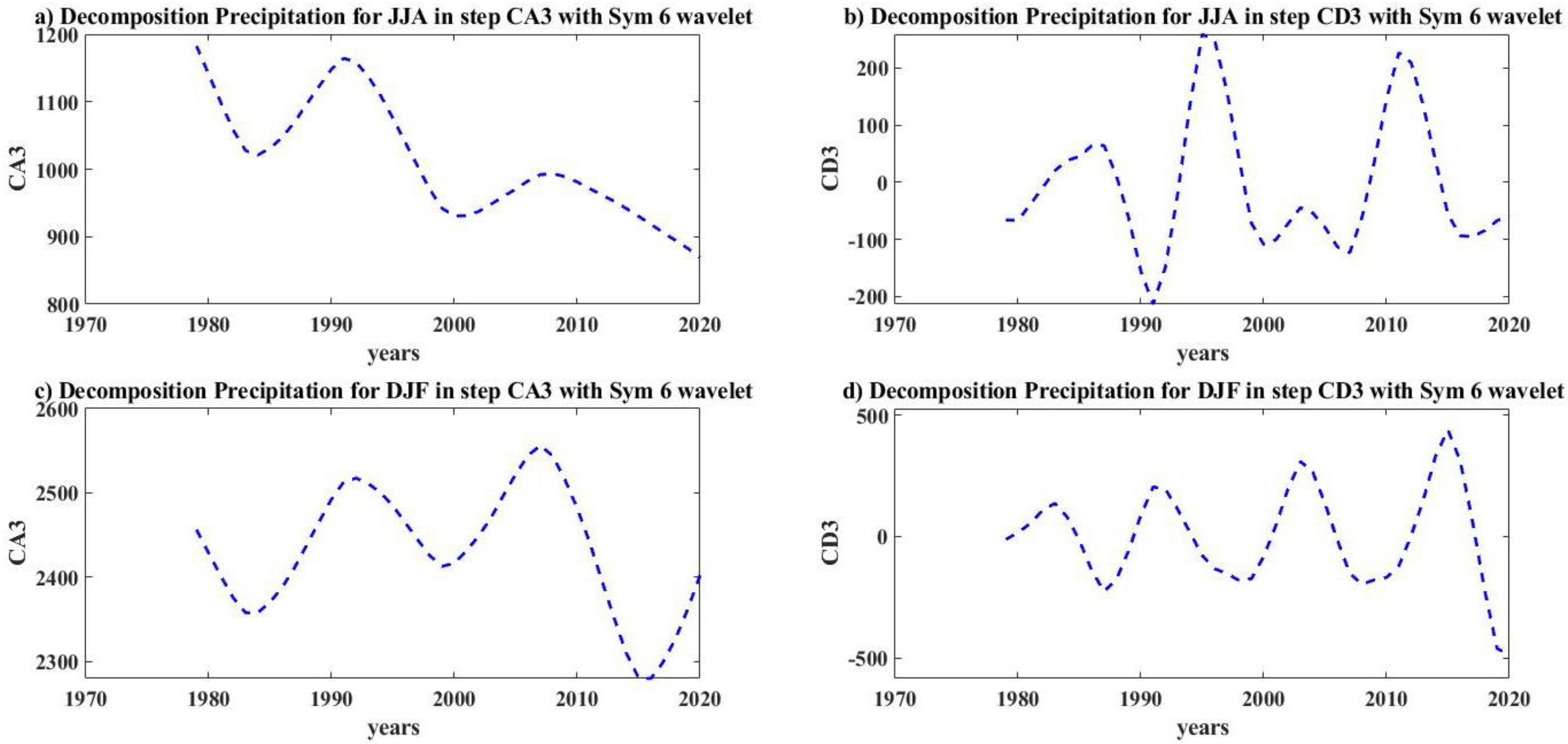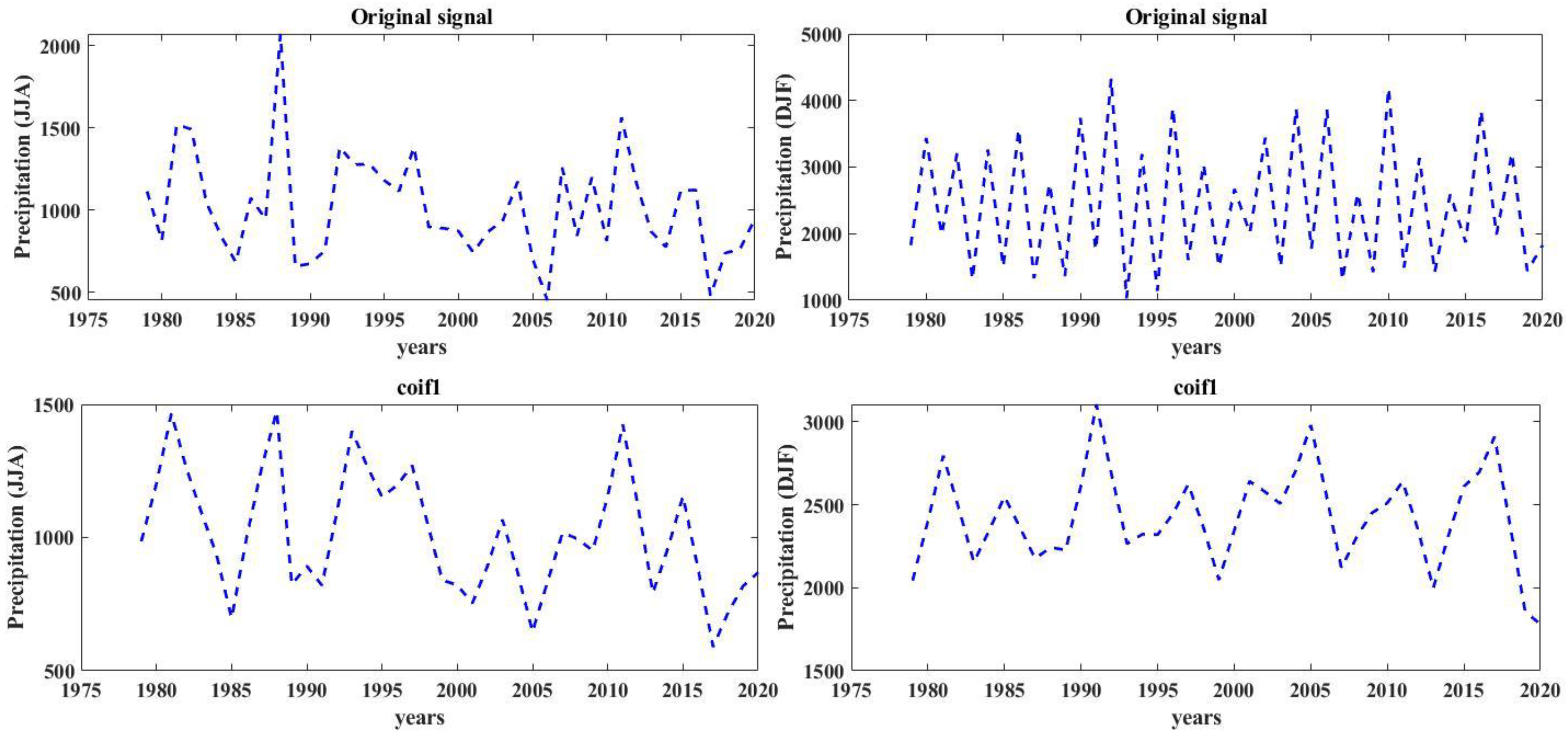Investigation and Analysis of Sea Surface Temperature and Precipitation of the Southern Caspian Sea Using Wavelet Analysis
Abstract
1. Introduction
2. Materials and Methods
2.1. Materials
2.2. Methods
3. Wavelet
3.1. Wavelet Discrete Transformation
3.2. Multistage Decomposition
3.3. Choosing the Proposed Filter Using the Wavelet Function
4. Wave Reconstruction
5. Results
5.1. Decomposition of Climate Data Time Series
5.1.1. Decomposition of SST Data
5.1.2. Decomposition of Precipitation Data
5.2. Wavelet Function Selection for Use with the Suggested Filter
5.3. Wavelet Analysis
6. Conclusions
Author Contributions
Funding
Data Availability Statement
Acknowledgments
Conflicts of Interest
References
- Arpe, K.; Molavi-Arabshahi, M.; Leroy, S.A.G. Wind variability over the Caspian Sea, its impact on Caspian seawater level and link with ENSO. Int. J. Climatol. 2020, 40, 6039–6054. [Google Scholar] [CrossRef]
- Lau, W.K.M.; Kim, K. The 2010 Pakistan Flood and Russian Heat Wave: Teleconnection of Hydrometeorological Extremes. J. Hydrometeorol. 2021, 13, 392–403. [Google Scholar] [CrossRef]
- Molavi-Arabshahi, M.; Arpe, K.; Leroy, S.A.G. Precipitation and temperature of the southwest Caspian Sea region during the last 55 years: Their trends and teleconnections with large-scale atmospheric phenomena. Int. J. Climatol. 2015, 35, 2156–2172. [Google Scholar] [CrossRef]
- Yang, C.; Sha, D.; Liu, Q.; Li, Y.; Lan, H.; Guan, W.W.; Hu, T.; Li, Z.; Zhang, Z.; Thompson, J.H.; et al. Taking the pulse of COVID-19: A spatiotemporal perspective. Int. J. Digit. Earth 2022, 13, 1186–1211. [Google Scholar] [CrossRef]
- Pagnottoni, P.; Spelta, A.; Flori, A.; Pammolli, F. Climate change and financial stability: Natural disaster impacts on global stock markets. Phys. A Stat. Mech. Its Appl. 2022, 599, 127514. [Google Scholar] [CrossRef]
- Yu, M.; Yang, C.; Li, Y. Big Data in Natural Disaster Management: A Review. Geosciences 2018, 8, 165. [Google Scholar] [CrossRef]
- Pagnottoni, P.; Spelta, A.; Pecora, N.; Flori, A.; Pammolli, F. Financial earthquakes: SARS-CoV-2 news shock propagation in stock and sovereign bond markets. Phys. A: Stat. Mech. Its Appl. 2021, 582, 126240. [Google Scholar] [CrossRef]
- Yun, H.; Jun, L. Teleconnection between climate oscillations and riverine nutrient dynamics in Southeast China based on wavelet analysis. Environ. Sci. Pollut. Res. 2021, 28, 41807–41820. [Google Scholar] [CrossRef]
- Morlet, J. Sampling Theory and Wave Propagation. In Issues in Acoustic Signal—Image Processing and Recognition; NATO ASI Series (Series F: Computer and System Sciences); Chen, C.H., Ed.; Springer: Berlin/Heidelberg, Germany, 1983; Volume 1. [Google Scholar] [CrossRef]
- Sunjay, S. Sequence Stratigraphy by Wavelet Analysis of Well Logging Data. In Proceedings of the International Conference on Recent Develop-ments in Stratigraphy, Pune University, Pune, India, 12–18 December, 2013. [Google Scholar]
- Torrence, C.; Compo, G.P. A Practical Guide to Wavelet Analysis. Bull. Am. Meteorol. Soc. 1998, 79, 61–78, Retrieved 28 October 2022. [Google Scholar] [CrossRef]
- Jiangtao, X.; Pingpinfg, L. Application of Wavelet Analysis in the Prediction of Telemetry Data. Int. J. Adv. Netw. Monit. Control. 2019, 4, 28–34. [Google Scholar] [CrossRef]
- Strang, G.; Nguyen, T. Wavelets and Filter Banks; Wellesley-Cambridge Press: New York, NY, USA, 1996. [Google Scholar]
- Pandey, B.K.; Tiwari, H.; Khare, D. Trend analysis using discrete wavelet transform (DWT) for long-term precipitation (1851–2006) over India. Hydrol. Sci. J. 2017, 62, 2187–2208. [Google Scholar] [CrossRef]
- Timoshevskaya, O.; Londikov, V.; Andreev, D.; Samsonenkov, V.; Klets, T. Digital data Processing Based on wavelet transforms. In Proceedings of the Environment Technology Resources Proceedings of the International Scientific and Practical Conference, 17–18 June 2021; Volume 2, pp. 174–180. [Google Scholar] [CrossRef]
- Mallat, S. A theory for multiresolution signal decomposition: The wavelet representation. IEEE Tran. Pat. Anal. Mach. Intel. 1989, 11, 674–693. [Google Scholar] [CrossRef]
- Papaioannou, V.E.; Chouvarda, I.G.; Maglaveras, N.K.; Pneumatikos, I.A. Temperature variability analysis using wavelets and multiscale entropy in patients with systemic inflammatory response syndrome, sepsis, and septic shock. Crit. Care 2012, 16, R51. [Google Scholar] [CrossRef] [PubMed]
- Zahavi, G.; Rosenstein, Y. Weather Derivative Pricing with Nonlinear Weather Forecasting. 21 May 2012. ACRN Journal of Finance and Risk Perspectives. ISSN 2305-7394. Available online: https://ssrn.com/abstract=2204179 (accessed on 22 May 2011). [CrossRef]
- Qixuan, Z. Dynamic Moment Analysis of Non-Stationary Temperature Data in Alberta. Master’s Thesis, Faculty of Management, University of Lethbridge, Lethbridge, AB, Canada, 2008. [Google Scholar]
- Manimaran, P.; Panigrahi Prasanta, K.; Parikh Jitendra, C. Wavelet analysis and scaling properties of time series. Phys. Rev. E J. 2005, 72, 046120–046125. [Google Scholar] [CrossRef]
- Sleziak, P.; Hlavčová, K.; Szolgay, J. Advantages of a Time Series Analysis Using Wavelet Transform as Compared with a Fourier Analysis. Slovak J. Civ. Eng. 2015, 23, 30–36. [Google Scholar] [CrossRef]
- Wang, Z.; Lv, G.; Chang, J.; Zhang, S.; Luo, S.; Jia, C.; Jiang, S.; Sun, B.; Liu, Y.; Liu, X. An Improved Denoising Method in RDTS Based on Wavelet Transform Modulus Maxima. IEEE Sens. J. 2015, 15, 1061–1067. [Google Scholar] [CrossRef]
- Xiaomei, S.; Xu, Y.; Yan, C. Wavelet Analysis of Rainfall Variation in the Yellow River Basin. Acta Scicentiarum Nat. Univ. Pekinesis 2006, 42, 503–509. [Google Scholar]
- Emmanuel, C.N.; Gerardo, R.J.; Anatoly, M. Wavelet analysis for spectral inversion of seismic reflection data. J. Appl. Geophys. 2020, 177, 104034. [Google Scholar] [CrossRef]
- Longo, C.; Burr, T.; Myers, K. Change Detection Using Wavelets in Solution Monitoring Data for Nuclear Safeguards. Axioms 2013, 2, 271–285. [Google Scholar] [CrossRef]
- Zeng, K.; Chen, D.; Ouyang, G.; Wang, V.; Liu, X.; Li, X. An EEMD-ICA Approach to Enhancing Artifact Rejection for Noisy Multivariate Neural Data. IEEE Trans. Neural Syst. Rehabil. Eng. 2016, 24, 630–638. [Google Scholar] [CrossRef] [PubMed]
- Gallegati, M.; Ramsey, J.B.; Semmler, W. Time Scale Analysis of Interest Rate Spreads and Output Using Wavelets. Axioms 2013, 2, 182–207. [Google Scholar] [CrossRef]
- Tamilselvi, P.R.; Thangaraj, P. Noise suppression and improved edge texture analysis in kidney ultrasound images. In Proceedings of the International Conference on Innovative Computing Technologies (ICICT), Karur, India, 12–13 February 2010; pp. 1–6. [Google Scholar] [CrossRef]
- Tan, M.; Qiu, A. Spectral Laplace-Beltrami Wavelets with Applications in Medical Images. IEEE Trans. Med. Imaging 2012, 34, 1005–1017. [Google Scholar] [CrossRef] [PubMed]
- Nalley, D.; Adamowski, J.; Khalil, B.; Ozga-Zielinski, B. Trend detection in surface air temperature in Ontario and Quebec, Canada during 1967–2006 using the discrete wavelet transform. Atmos. Res. 2013, 132–133, 375–398. [Google Scholar] [CrossRef]
- Fredriksen, H.B. Long-Range Memory in Earth Surface Temperatures: Spatial Scale Dependence and Land-Sea Differences. Master’s Thesis, Faculty of Science and Technology, Department of Physics and Technology, University of Tromsø, Tromsø, Norway, 2013. [Google Scholar]
- Kwon, H.H.; Lall, U.; Khalil, A.F. Stochastic simulation model for nonstationary time series using an autoregressive wavelet decomposition: Applications to rainfall and temperature. Water Resour. Res. 2007, 43, W05407. [Google Scholar] [CrossRef]
- Nason, G.P. Choice of the Threshold Parameter in Wavelet Function Estimation. In Wavelets and Statistics. Lecture Notes in Statistics; Antoniadis, A., Oppenheim, G., Eds.; Springer: New York, NY, USA, 1995; Volume 103. [Google Scholar] [CrossRef]
- Camps, A.; Tarongi, J.M. RFI Mitigation in Microwave Radiometry Using Wavelet. Algorithm 2009, Algorithm 2, Algorithm 1248, Algorithm 1249, Algorithm 1250, Algorithm 1251, Algorithm 1252, Algorithm 1253, Algorithm 1254, Algorithm 1255, Algorithm 1256, Algorithm 1257, Algorithm 1258, Algorithm 1259, Algorithm 1260, Algorithm 1261 and Algorithm 1262 2009, 2, 1248–1262. [Google Scholar] [CrossRef]
- Schimmack, M.; Nguyen, S.; Mercorelli, P. Implemented Wavelet Packet Tree based Denoising Algorithm in Bus Signals of a Wearable Sensorarray. J. Phys. Conf. Ser. 2015, 659, 1–9. [Google Scholar] [CrossRef]
- Anctil, F.; Coulibaly, P. Wavelet Analysis of the Interannual Variability in Southern Quebec Streamflow. J. Clim. 2004, 17, 163–173. [Google Scholar] [CrossRef]
- Abdul Karim, S.A.B.; Ismail, M.T.; Hasan, M.K.; Sulaiman, J. Denoising the temperature data using wavelet transform. Appl. Math. Sci. 2013, 7, 5821–5830. [Google Scholar] [CrossRef][Green Version]
- de Alcântara, E.H.; Stech, J.L.; Lorenzzetti, J.A.; de Moraes, E.M.L. Time series analysis of water surface temperature and heat flux components in the Itumbiara Reservoir (GO), Brazil. Acta Limnol. Bras. 2011, 23, 245–259. [Google Scholar] [CrossRef][Green Version]
- Xiaohong, L.; Shujuan, Y.; Li, L. Prediction of Temperature Time Series Based on Wavelet Transform and Support Vector Machine. J. Comput. 2012, 7, 8. [Google Scholar] [CrossRef][Green Version]
- Tangborn, A. Wavelet approximation of error covariance propagation in data assimilation. Tellus A Dyn. Meteorol. Oceanogr. 2004, 56, 16–28. [Google Scholar] [CrossRef]
- Jianmin, F.; Xu, L.; Zhi, Z. Analysis on Multi-Scale Features of Precipitation in East and Middle Part of Northwest China and West Mongloia. Sci. Meteorol. Sin. 2005, 25, 474–482. [Google Scholar]
- Hersbach, H.; Bell, B.; Berrisford, P.; Biavati, G.; Hor_anyi, A.; Muñoz, S.J.; Nicolas, J.; Peubey, C.; Radu, R.; Rozum, I.; et al. ERA5 monthly averaged data on single levels from 1979 to present. Copernicus Climate Change Service (C3S) Climate Data Store (CDS) 2020, [Data Set]. Available online: https://doi.org/10.24381/cds.f17050d7 (accessed on 28 October 2022).
- Colombo, F.; Magazu, S.; Caccamo, M.T. Wavelet Analysis as a Tool for Characterizing Trends in Climatic Data. January 2018. Available online: https://hdl.handle.net/11570/3126996 (accessed on 28 October 2022).
- Akujuobi, C.M. Wavelets and Wavelet Transform Systems and Their Applications; Springer: Cham, Switzerland, 2022. [Google Scholar]
- Bhatnagar, N. Introduction to Wavelet Transforms. Chapman and Hall/CRC: New York, NY, USA, 2020. [Google Scholar]















| Reconstruction Maximum Error | SST JJA | SST DJF | Prec JJA | Prec DJF |
|---|---|---|---|---|
| Level 1 | ||||
| Level 2 | ||||
| Level 3 |
| Wavelet Function | Coefficients | Energy (%) | |||
|---|---|---|---|---|---|
| SST (JJA) | SST (DJF) | Prec (JJA) | Prec (DJF) | ||
| sym3 | 6 | 96.22 | 91.34 | 95.23 | 90.59 |
| sym4 | 8 | 95.31 | 92.29 | 94.76 | 91.50 |
| sym5 | 10 | 96.45 | 93.31 | 95.46 | 92.00 |
| sym6 | 12 | 96.37 | 93.49 | 95.76 | 92.43 |
| coif1 | 6 | 95.72 | 90.52 | 94.85 | 89.85 |
| coif2 | 12 | 97.81 | 93.72 | 95.44 | 92.65 |
| coif3 | 18 | 97.92 | 95.43 | 96.01 | 93.71 |
Disclaimer/Publisher’s Note: The statements, opinions and data contained in all publications are solely those of the individual author(s) and contributor(s) and not of MDPI and/or the editor(s). MDPI and/or the editor(s) disclaim responsibility for any injury to people or property resulting from any ideas, methods, instructions or products referred to in the content. |
© 2022 by the authors. Licensee MDPI, Basel, Switzerland. This article is an open access article distributed under the terms and conditions of the Creative Commons Attribution (CC BY) license (https://creativecommons.org/licenses/by/4.0/).
Share and Cite
Molavi-Arabshahi, M.; Azizpour, J.; Nikan, O.; Naderi Beni, A.; Lopes, A.M. Investigation and Analysis of Sea Surface Temperature and Precipitation of the Southern Caspian Sea Using Wavelet Analysis. Axioms 2023, 12, 10. https://doi.org/10.3390/axioms12010010
Molavi-Arabshahi M, Azizpour J, Nikan O, Naderi Beni A, Lopes AM. Investigation and Analysis of Sea Surface Temperature and Precipitation of the Southern Caspian Sea Using Wavelet Analysis. Axioms. 2023; 12(1):10. https://doi.org/10.3390/axioms12010010
Chicago/Turabian StyleMolavi-Arabshahi, Mahboubeh, Jafar Azizpour, Omid Nikan, Abdolmajid Naderi Beni, and António M. Lopes. 2023. "Investigation and Analysis of Sea Surface Temperature and Precipitation of the Southern Caspian Sea Using Wavelet Analysis" Axioms 12, no. 1: 10. https://doi.org/10.3390/axioms12010010
APA StyleMolavi-Arabshahi, M., Azizpour, J., Nikan, O., Naderi Beni, A., & Lopes, A. M. (2023). Investigation and Analysis of Sea Surface Temperature and Precipitation of the Southern Caspian Sea Using Wavelet Analysis. Axioms, 12(1), 10. https://doi.org/10.3390/axioms12010010








